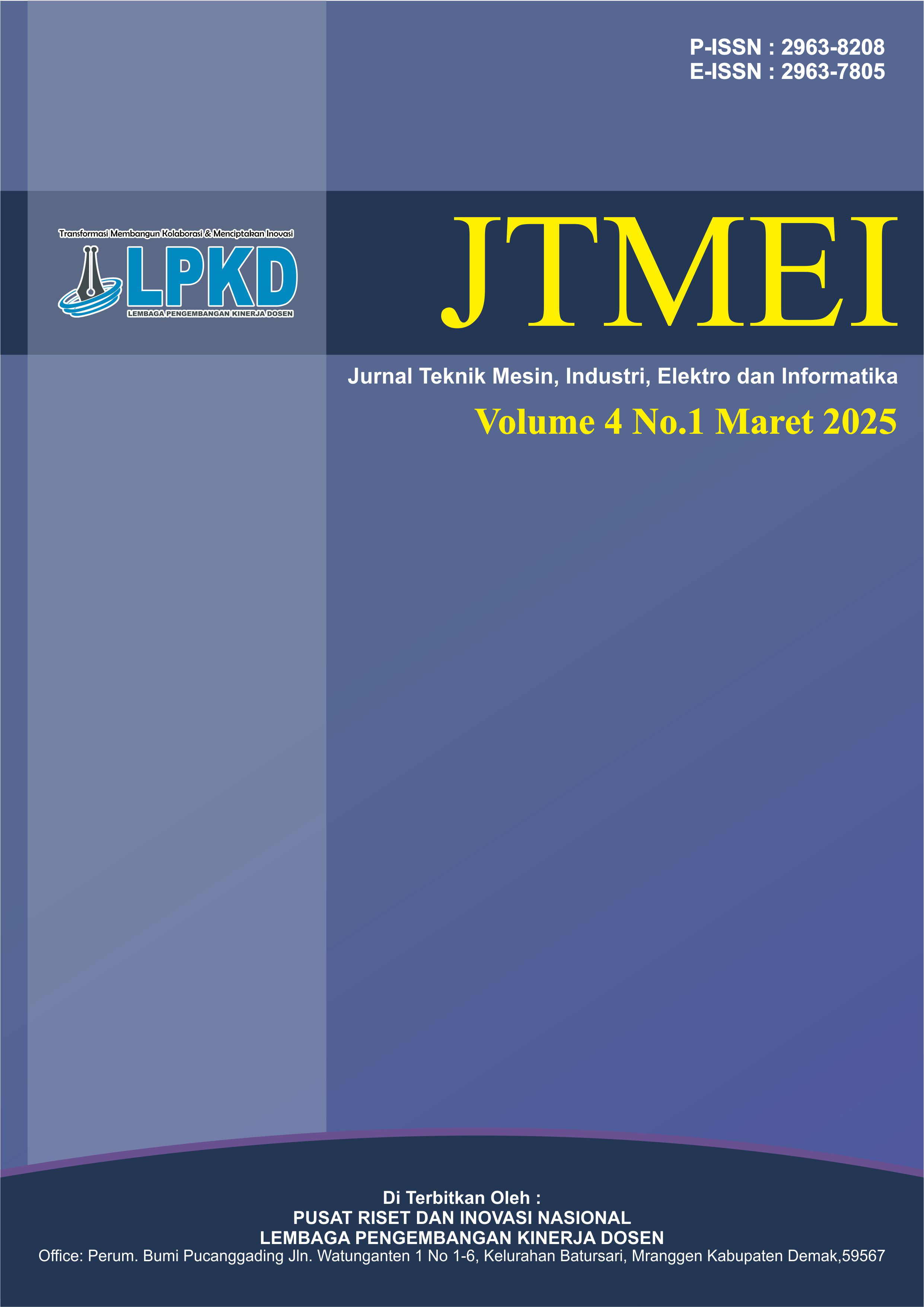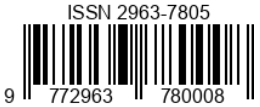Optimizing Coffee Ripeness Classification Using Yolov5 for Automated Detection and Sorting
DOI:
https://doi.org/10.55606/jtmei.v4i1.4821Keywords:
Coffee classification, Object detection, Internet of Thinks, Deep learning, YOLOv5Abstract
The quality of agricultural products, particularly coffee beans, is crucial in today's global market, which demands precise ripeness classification due to its high commercial value. Traditional manual methods in coffee plantations, heavily reliant on human labor to determine quality, often result in inefficiencies and inaccuracies. To address this issue, this study developed an automated coffee ripeness detection system using the YOLOv5 machine learning algorithm, combined with Raspberry Pi, webcam, and servo motor. By integrating YOLOv5, the system enables real-time classification of coffee beans into three categories: ripe, unripe, and rotten, with an average accuracy of 90% during real-time testing. This system not only reduces dependence on manual labor but also improves process efficiency across various environmental conditions. The findings suggest that the application of this technology can significantly enhance productivity in the coffee industry, while providing a foundation for further advancements in automation and classification methodologies in the agricultural sector.
Downloads
References
Adiwijaya, N. O., Romadhon, H. I., Putra, J. A., & Kuswanto, D. P. (2022). The quality of coffee bean classification system based on color by using K-nearest neighbor method. Journal of Physics: Conference Series, 2157(1), 012034. https://doi.org/10.1088/1742-6596/2157/1/012034
Ardra Prakash, D. (2024). A comparative analysis of object identification labelling platforms: Basketball perspective. International Journal of Media and Networks, 2(3), 01–04. https://doi.org/10.33140/IJMN.02.03.02
Damayanti, I. D., & Michael, A. (2024). Determination of coffee fruit maturity level using image histogram and K-nearest neighbor. BAREKENG: Jurnal Ilmu Matematika dan Terapan, 18(2), 0785–0796. https://doi.org/10.30598/barekengvol18iss2pp0785-0796
de Figueiredo Tavares, M. P., & Mourad, A. L. (2020). Coffee beverage preparation by different methods from an environmental perspective. The International Journal of Life Cycle Assessment, 25(7), 1356–1367. https://doi.org/10.1007/s11367-019-01719-2
Flores-Calero, M., Astudillo, C. A., Guevara, D., Maza, J., Lita, B. S., Defaz, B., Ante, J. S., Zabala-Blanco, D., & Armingol Moreno, J. M. (2024). Traffic sign detection and recognition using YOLO object detection algorithm: A systematic review. Mathematics, 12(2), 297. https://doi.org/10.3390/math12020297
Gope, H. L., Fukai, H., Ruhad, F. M., & Barman, S. (2024). Comparative analysis of YOLO models for green coffee bean detection and defect classification. Scientific Reports, 14(1), 28946. https://doi.org/10.1038/s41598-024-78598-7
Gupta, A. K., Seal, A., Prasad, M., & Khanna, P. (2020). Salient object detection techniques in computer vision—a survey. Entropy, 22(10), 1174. https://doi.org/10.3390/e22101174
Hayati, N. J., Singasatia, D., Muttaqin, M. R., Teknik Informatika, Sekolah Tinggi, & Teknologi Wastukancana. (2023). Object tracking menggunakan algoritma You Only Look Once (YOLO)v8 untuk menghitung kendaraan. KOMPUTA: Jurnal Ilmiah Komputer dan Informatika, 12(2).
Hidayah, N. (2024). Implementasi algoritma multinomial naïve bayes, TF-IDF dan confusion matrix dalam pengklasifikasian saran monitoring dan evaluasi mahasiswa terhadap dosen teknik informatika Universitas Dayanu Ikhsanuddin. Jurnal Akademik Pendidikan Matematika, 10(1). https://doi.org/10.55340/japm.v10i1.1491
Janiesch, C., Zschech, P., & Heinrich, K. (2021). Machine learning and deep learning. Electronic Markets, 31(3), 685–695. https://doi.org/10.1007/s12525-021-00475-2
Laghari, A. A., Wu, K., Laghari, R. A., Ali, M., & Khan, A. A. (2022). RETRACTED ARTICLE: A review and state of art of Internet of Things (IoT). Archives of Computational Methods in Engineering, 29(3), 1395–1413. https://doi.org/10.1007/s11831-021-09622-6
Liu, C., Lin, W., Feng, Y., Guo, Z., & Xie, Z. (2023). ATC-YOLOv5: Fruit appearance quality classification algorithm based on the improved YOLOv5 model for passion fruits. Mathematics, 11(16), 3615. https://doi.org/10.3390/math11163615
Mansour, M., Gamal, A., Ahmed, A. I., Said, L. A., Elbaz, A., Herencsar, N., & Soltan, A. (2023). Internet of things: A comprehensive overview on protocols, architectures, technologies, simulation tools, and future directions. Energies, 16(8), 3465. https://doi.org/10.3390/en16083465
Markoulidakis, I., Kopsiaftis, G., Rallis, I., & Georgoulas, I. (2021). Multi-class confusion matrix reduction method and its application on Net Promoter Score classification problem. In Proceedings of the 14th PErvasive Technologies Related to Assistive Environments Conference (pp. 412–419). New York, NY, USA: ACM.
Phan, Q.-H., Nguyen, V.-T., Lien, C.-H., Duong, T.-P., Hou, M. T.-K., & Le, N.-B. (2023). Classification of tomato fruit using YOLOv5 and convolutional neural network models. Plants, 12(4), 790. https://doi.org/10.3390/plants12040790
Ragab, M. G., Abdulkadir, S. J., Muneer, A., Alqushaibi, A., Sumiea, E. H., Qureshi, R., Al-Selwi, S. M., & Alhussian, H. (2024). A comprehensive systematic review of YOLO for medical object detection (2018 to 2023). IEEE Access, 12, 57815–57836. https://doi.org/10.1109/ACCESS.2024.3386826
Ridam Lokhande, Y., Nakhale, N., Petkar, N., Sheikh, T., Janwe, N., & Lichode, R. V. (2023). Object detection. International Journal of Advanced Research in Science, Communication and Technology, 316–320. https://doi.org/10.48175/IJARSCT-14042
Satria, G. J., Adikara, P. P., & Wihandika, R. C. (2022). Klasifikasi pertanyaan COVID-19 bahasa Indonesia menggunakan Naïve Bayes. Vol. 6.
Suci Amaliah, M., Nusrang, M., & Aswi, A. (2022). Penerapan metode random forest untuk klasifikasi varian minuman kopi di Kedai Kopi Konijiwa Bantaeng. VARIANSI: Journal of Statistics and Its Application on Teaching and Research, 4(3), 121–127. https://doi.org/10.35580/variansiunm31
Tamayo-Monsalve, M. A., Mercado-Ruiz, E., Villa-Pulgarin, J. P., Bravo-Ortiz, M. A., Arteaga-Arteaga, H. B., Mora-Rubio, A., Alzate-Grisales, J. A., Arias-Garzon, D., Romero-Cano, V., Orozco-Arias, S., Gustavo-Osorio, G., & Tabares-Soto, R. (2022). Coffee maturity classification using convolutional neural networks and transfer learning. IEEE Access, 10, 42971–42982. https://doi.org/10.1109/ACCESS.2022.3166515
Taye, M. M. (2023). Understanding of machine learning with deep learning: Architectures, workflow, applications and future directions. Computers, 12(5), 91. https://doi.org/10.3390/computers12050091
Zhang, H., & Speakman, J. R. (2024). The complexity of coffee and its impact on metabolism. Journal of Endocrinology, 262(3). https://doi.org/10.1530/JOE-24-0075
Downloads
Published
How to Cite
Issue
Section
License
Copyright (c) 2025 Jurnal Teknik Mesin, Industri, Elektro dan Informatika

This work is licensed under a Creative Commons Attribution-ShareAlike 4.0 International License.








